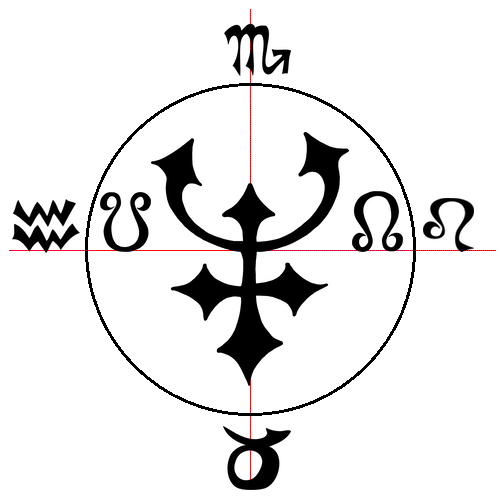
astrology glyphs designed by Bradley Naragon
Nodes of Neptune
Those who study and practice astrology are very familiar with the nodes of the Moon, yet across traditions of astrology there are diverse, sometimes conflicting, ways of interpreting and using them. One thing astrologers agree on is that exploring the nodes of the Moon in natal charts and transits unlocks significant information. Not as many people pay attention to the nodes of the other planets, but once you begin contemplating them you will discover there is rich meaning to be found in their placements that also has a mysterious quality difficult to capture in keywords and tidy definitions. It as if the archetypal force of the associated planet ascends and descends like waves from the oceanic world soul or collective unconscious when its planetary nodes are active. This strange, significant influence is especially ineffable when contemplating Neptune and its planetary nodes. There have been a series of astrological transits unveiling Neptune’s collective influence through the activation of its planetary nodes recently, and so it’s worth considering your personal as well as our collective relationship with Neptune in these present times.
Dane Rudhyar published The Planetary and Lunar Nodes in 1971, a short text loaded with insight into the nodes of the Moon as well as all of the other planets. Rudhyar was clearly impressed with the significance of the planetary nodes, writing that having the nodes of Uranus (or any planet) conjoining the ascendant or midheaven is more significant than having Uranus (or the nodal planet) conjoining the ascendant or midheaven because the planetary nodes illuminate an essential “quality of being related to the space of its entire orbit.” Notably, Rudhyar did not root his analysis of planetary nodes in only new age, modern astrology concepts but also in ancient astrological understanding. He wrote:
Indeed, in philosophical traditions concerning the meaning of astrology it was stated that the fundamental reality of what we call a planet is not its material mass but rather the space which its movements define.
— Dane Rudhyar, The Planetary and Lunar Nodes
Moreover, the method utilized by Rudhyar in The Planetary and Lunar Nodes has a strong connection to the same techniques utilized by ancient Mesopotamian astrologers who placed great significance on dynamic points of change in lunar latitude, information found through paying attention to when the Moon conjoins or forms a square to its own nodes. The nodes of the Moon demarcate the places of eclipses whenever a New Moon or Full Moon forms in close proximity to their placement. This is due to the lunar nodes marking the intersection of the ecliptic (the apparent path of our Sun that forms the zodiac) with the arc of the Moon’s orbit. The lunar nodes also mark when the Moon transitions from southern into northern latitude or vice versa.

from Earthsky.org
When the Moon approaches and then moves through a conjunction with its North Node of the Moon, in the northern hemisphere this means the Moon is moving from southern latitude into being on the ecliptic when it forms its union with the North Node. This means essentially the Moon is now on the orbital plane of our planet, and Rudhyar therefore interpreted this as meaning the Moon (or any planet conjoining its North Node) more readily saturating and flooding our earth-based consciousness with its influence. Ancient sky watchers noted this as a point of dynamic change, as the Moon was in transition of moving from southern into northern latitude.
As the Moon moves past the North Node by zodiacal degree it continues to elevate in northern latitude until it forms a square to the lunar nodes, at which point it has reached another dynamic point of change also called the northern bending. At this peak point the Moon is at maximum northern latitude (about five degrees for the Moon) and thus begins to descend in latitude until it forms a conjunction with the South Node of the Moon, moving from northern into southern latitude. To Rudhyar, when the Moon is conjoining its own South Node it means it is once again strongly impacting our consciousness by being aligned with our orbital plane around the Sun. This is a third dynamic point of change in latitude.
When the Moon once again forms a square to the nodes following its conjunction with its South Node it is at its southern bending, its maximum point of southern latitude before beginning to head back toward the ecliptic and the North Node of the Moon. This is the fourth and final dynamic point of change in latitude. Rudhyar stressed the importance of paying attention to when the Moon forms a conjunction with its North Node, then northern bending, then South Node, then southern bending and around again to another union with the North Node, as this taps us into a dynamic process of lunar change. Interestingly, ancient Hellenistic astrologers such as Vettius Valens were aware of the unstable, volatile nature of these points in the Moon’s orbit and advised against electing charts for events whenever the Moon was conjoining or forming a square to one of its own nodes.

Lunar Planisphere by John Russell (1806); Astrology glyphs by Bradley Naragon
“The two nodes are not separate points each with its individual meaning; they are the two polar aspects of one single process. What should be studied and understood is, first of all, the process.
In the case of planetary nodes, I repeat, what is at stake is the fundamental relationship of a planet and of our Earth as two related members of the solar system. More specifically, in terms of individual birth-charts, it is the manner in which the essential quality of a planet affects the very structure and the roots of our individuality as a member of the human species.”
— Dane Rudhyar, The Planetary and Lunar Nodes
The North Node to Rudhyar is a point of intake he associated with a metabolic process of building personality through the absorption of new material. Rudhyar stressed the importance of properly metabolizing, digesting, and integrating the new material assimilated by consciousness, otherwise it will lead to challenging, negative issues when the Moon (or planet) reaches its South Node. The South Node to Rudhyar is not only a release in the manner of decay or disintegration, but also a seed-like re-channeling into mental, creative, and spiritual development. Rudhyar wrote at the South Node there can be both the putrefaction of poisonous, toxic material as well as positive, creative expression.
In particular, Rudhyar connected the South Node points as being about an expansion of personality rather than building, and that it positively involves dedication to an ideal or community focus. Similar to how the South Node can be a place of sacrificial fires of purification in Indian astrology, Rudhyar also described the South Node as a place of sacrifice as in “making sacred” rather than egoic sacrifice in which we expect something in return. When the Moon (or other planet) comes around in its orbit to descend across the South Node from northern into southern latitude, it is as if the entire arc of material being assimilated since the most recent union with the North Node becomes focused in consciousness and must be processed and released:
“When a planet is at its north node, its essential function and quality in the solar system is focused upon our Earth-space which is then most able to absorb and assimilate it. When the planet is at its south node what is released as ‘substantial’ factors are the results of the relationship between the characteristic nature of the planet and whatever in the Earth-space has absorbed its power.
If the relationship has been positive, then what has been absorbed has also been ‘assimiliated’ and integrated to the Earth-consciousness and has produced a new ‘seed,’ i.e., new experiences and values. If the relationship has proven negative, what is being released or exteriorized are disintegrating materials, or negative existential results.”
–Dane Rudhyar, The Planetary and Lunar Nodes
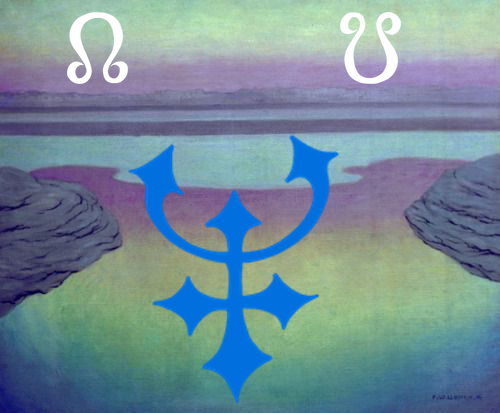
Background by Felix Vallotton; astrology glyphs by Bradley Naragon
When the Moon or planet is in square to the nodes, at either the northern or southern bending, Rudhyar stated it “operates with a minimum degree of focalization in earth-nature… The Moon [or planet] is as far withdrawn from the Earth…yet…is most active in her own sphere. What happens in that sphere during… maximum latitude becomes focused and exteriorized” when the Moon [or planet] conjoins its nodes. These are times in “which all that the Moon [or planet] represents in the fields of… organic psychological and social activity is brought to focus in… consciousness.”
Rudhyar distinguished between the impact of a planet crossing its north node, which he saw as involving a greater degree of cooperation between the archetypal force of the planet and the Earth, with the impact of a planet crossing its own south node, which he saw as being challenging in terms of an outpouring of the archetypal force descending across the ecliptic. He wrote, “At its south node the characteristic quality of a planet is almost forcibly thrown upon the Earth.” Currently we are experiencing Pluto in Capricorn conjoining its own South Node in Capricorn, and so the Plutonic archetype is being forcibly unleashed throughout our collective consciousness. Pluto was last at its North Node in Cancer in 1930, a topic I will return to explore in a future article.
It is important to note that Rudhyar worked with the heliocentric nodes of the planets when analyzing the dynamic process of latitude change, rather than the geocentric nodes of the planets. Since the Moon actually orbits the Earth, the fact we use the geocentric nodes of the Moon is accurate and results in the North Node and South Node of the Moon always being opposite one another in polarity. However, since the other planets do not orbit around the Earth, although their geocentric nodal placements are interesting to consider in astrology (for example, Jeff Green used the geocentric nodal placements in his work), it is only when we consider the heliocentric placements that we find the planetary nodes to be at opposite points of polarity. Rudhyar also felt the heliocentric planetary nodes tap us more strongly into the relationship between our orbit around the Sun and the orbits of the other planets around the Sun.
With regard to Neptune and its planetary nodes, we last experienced a conjunction of Neptune with its South Node in Aquarius in 2002 through 2004, with the current movement of Neptune across Pisces taking us into deeper Neptunian southern latitude. Since the North Node of Neptune is in Leo between 11 and 12 degrees, and the South Node of Neptune is in Aquarius between 11 and 12 degrees, this means that the northern bending of Neptune when it forms a square to its own nodes at maximum northern latitude is in Scorpio between 11 and 12 degrees. This then means that when Neptune is in Taurus between 11 and 12 degrees that it is at its southern bending, its maximum southern latitude before it begins to ascend back toward the ecliptic. The graphic below has dates for when Neptune has been at each of these points in its orbital cycle:
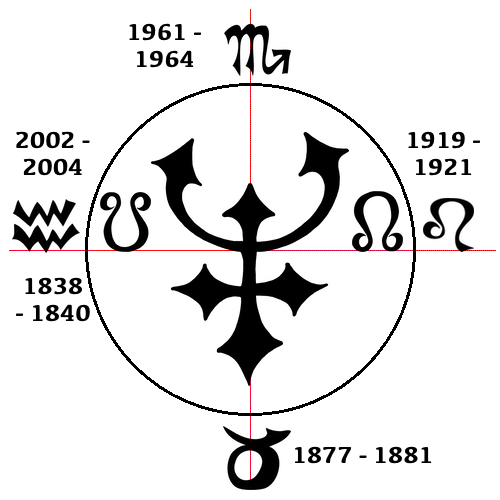 There are numerous historical lines of development across time from diverse cultural perspectives that can be correlated with Neptune at each of these four dynamic points of its orbital cycle. It is interesting that Neptune was discovered in 1846 not long after it had descended into southern latitude across the ecliptic. Furthermore, one of the traditional definitions of historical eras in Europe, the Victorian Era, began as Neptune conjoined its South Node in Aquarius in 1838 to 1840. One aspect of the Victorian Era relevant to an activation of the Neptunian archetype was a wave of Spiritualism such as mesmerism and seances. In fact, if we move forward to when Neptune was in Taurus at its southern bending, we can note this is the period of Madame Blavatsky and her Theosophist movement, including the publishing of Isis Unveiled in 1877.
There are numerous historical lines of development across time from diverse cultural perspectives that can be correlated with Neptune at each of these four dynamic points of its orbital cycle. It is interesting that Neptune was discovered in 1846 not long after it had descended into southern latitude across the ecliptic. Furthermore, one of the traditional definitions of historical eras in Europe, the Victorian Era, began as Neptune conjoined its South Node in Aquarius in 1838 to 1840. One aspect of the Victorian Era relevant to an activation of the Neptunian archetype was a wave of Spiritualism such as mesmerism and seances. In fact, if we move forward to when Neptune was in Taurus at its southern bending, we can note this is the period of Madame Blavatsky and her Theosophist movement, including the publishing of Isis Unveiled in 1877.
The Victorian era also involved societal repercussions from the Industrial Revolution, and as Neptune moved toward its southern bending there were not only numerous political revolutions across Europe but also the development of socialism and communism. In the United States of America, Neptune’s movement towards its southern bending in 1877 involved expansion of territory through warfare with indigenous civilizations, as well as the atrocities of slavery that led into underground railroads and abolitionist movements, as well as ultimately the U.S Civil War that freed slaves yet led into a reconstruction period that continued to enforce institutional racism. Neptune at its southern bending in 1877 saw Crazy Horse fighting his final battles, a railroad strike and riots by railroad workers, and Thomas Edison announcing his discovery of the phonograph which made the recording of sound possible.
Of course, its easy to see that as Neptune drew closer to aligning with its North Node in Leo in 1919 that not only did the first world war erupt, but also monumental political revolutions such as both the Mexican and Russian revolutions. By the time Neptune conjoined its North Node the first world war had ended, and there was an attempt to broker a new peace through the creation of the League of Nations in 1920. Through these eruptions of violent conflict, we can witness the extraordinary power struggles that correlate with Neptune’s orbital cycle- across history we can observe wars erupting that involve conflicts between the religious and idealistic dogma of those pitted against one another.
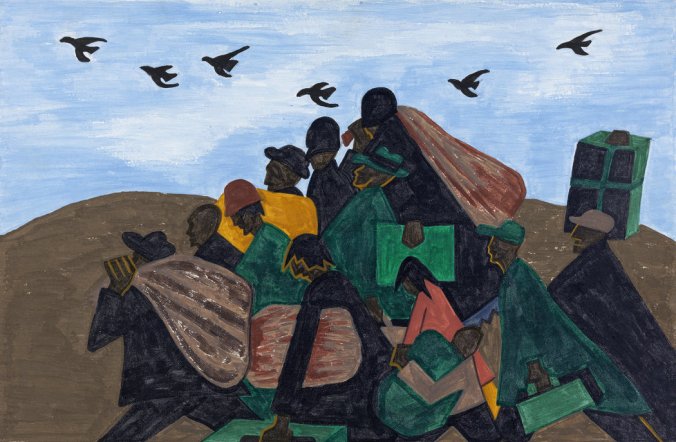
from The Migration Series by Jacob Lawrence, born with Neptune near its North Node in Leo
One element of Neptune having its North Node in Leo is creative actualization of the Neptune archetype, and in Europe during the first world war we can witness this with the development of the avant garde Dada art movement as Neptune approached and crossed over its North Node. In the United States of America, although African Americans continued to face severe racism, they also made an immense cultural impact through the arts with the development of jazz within black communities. In fact, the decade of the 1920s heralded by Neptune conjoining its North Node in Leo became known as the Jazz Age. In addition, there was also an African American artistic and literary movement proclaimed the Harlem Renaissance that developed as Neptune ascended across its North Node in Leo.
There are many events that can be connected with Neptune reaching its northern bending in Scorpio (1961 – 1964), one of the biggest being the powerful drive of the Civil Rights activism in the United States of America. These years witnessed the rallying of action by Malcolm X, the grandeur of the “I Have a Dream” speech and the profound resistance of the Birmingham campaign that led to a flooding of local jails by protesters, including Martin Luther King, Jr. who composed his “Letter from a Birmingham Jail” with Neptune at 14°47 Scorpio, only a couple of degrees past the northern bending of Scorpio. The utopian idealism and psychedelic waves in culture that erupted across the 1960s can also be connected with Neptune in Scorpio being at the peak of northern latitude and bending into descent.
As Neptune descended toward the ecliptic both personal computers and the Internet were created that led to an economic bubble of immense Internet profit as Neptune in Aquarius approached a conjunction with the South Node of Neptune in 2002 – 2004. The Internet bubble had burst by the time Neptune conjoined its own South Node in these years, but during the same period Neptune was crossing the ecliptic from northern into southern latitude, Facebook was created and Google went public. Facebook, Google, and other Internet giants have gained massive influence over the imaginal space of multitudes of people as Neptune has continued to deepen into southern latitude in the years since.
The years of Neptune conjoining its South Node in Aquarius also coincided with the United States of America going to war with Afghanistan and Iraq. The War with Iraq will always be remembered for being initiated by an illusion of weapons of mass destruction. As these wars involved a strongly Christian civilization going to war with dominant Islamic civilizations, it has a link to the crusades of the Middle Ages involving Christian armies invading Islamic lands. The period of the crusades in the Middle Ages is the same time that the Nodes of Neptune moved from being in Cancer and Capricorn into Leo and Aquarius.
It’s also possible to find patterns of development within literature and the arts, such as The Lord of the Rings stories by J.R.R. Tolkien. In 2004 as Neptune was crossing its South Node in Aquarius into southern latitude, the final story in the series, The Return of the King won an Oscar for Best Picture. Reportedly, J.R.R. Tollkien began writing the story that would eventually develop into the final narrative of The Lord of the Rings in 1917 when Neptune was beginning to cross its North Node from southern into northern latitude. It makes sense to me that some of the themes of The Lord of the Rings could be applied to the meaning of Neptune’s South Node being in Aquarius and it’s North Node in Leo. It’s possible to find links with many other diverse stories and art that align with Neptune’s nodal axis.
Thus if you have a natal chart placement close to 11 degrees of Aquarius, you have it aligned with the South Node of Neptune. If you have it at 11 degrees of Leo, you have it aligned with the North Node of Neptune. If you have it at 11 degrees of Scorpio, you have it at the northern bending of Neptune. If you have it at 11 degrees of Taurus, you have it at the southern bending of Neptune. We can also work in the transit of other planets into this. For example, Mars stationed retrograde a couple degrees away from the South Node of Neptune on 26 June 2018, and Mercury stationed direct on the North Node of Neptune on 19 August 2018. Both of these transits therefore activated the orbital arc of Neptune, essentially stirring up Neptunian material from the collective unconscious into our interconnected collective field.
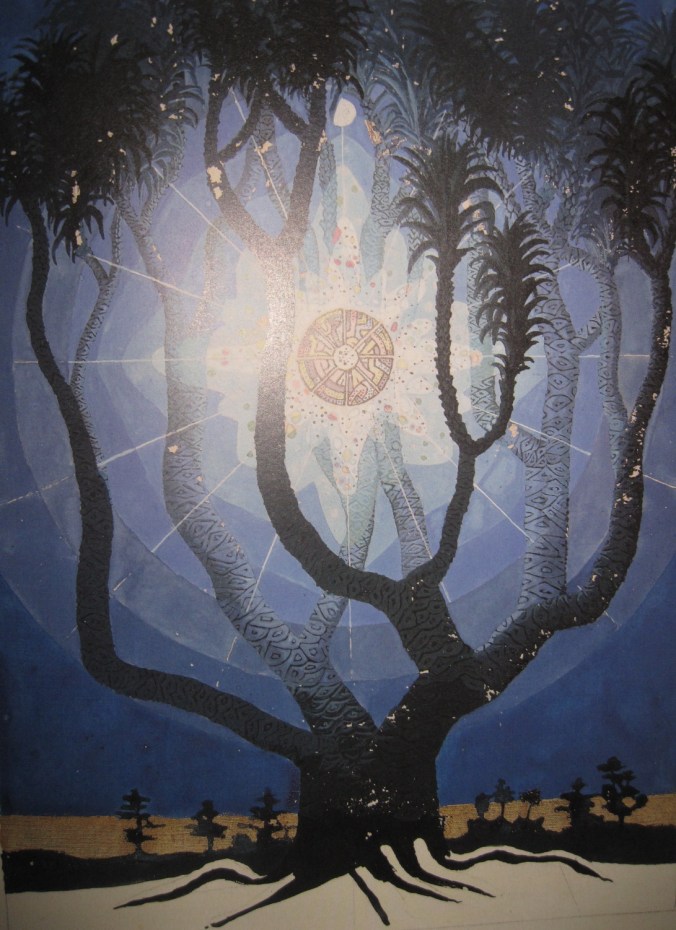
Image 131 from Liber Novus by C.G. Jung, born with Neptune in Taurus approaching southern bending of Neptune
The tension of the future is unbearable in us. It must break through narrow cracks, it must force new ways. You want to cast off the burden, you want to escape the inescapable. Running away is deception and detour. Shut your eyes so that you do not see the manifold, the outwardly plural, the tearing away and the tempting. There is only one way and that is your way; there is only one salvation and that is your salvation. Why are you looking around for help? Do you believe that help will come from outside? What is to come is created in you and from you. Hence look into yourself. Do not compare, do not measure. No other way is like yours. All other ways deceive and tempt you. You must fulfill the way that is in you.
— C.G. Jung, Liber Novus, 130
C.G. Jung is an example of someone born with Neptune approaching its southern bending in Taurus, as he was born in 1875 with Neptune at 3°02′ Taurus (about eight degrees away). This means that as Jung grew up, Neptune was moving from its deepest point of southern latitude up toward the ecliptic and its own North Node. As Neptune became closer to its North Node and the first world war erupted, Jung went into his theurgic descent of Red Book visions and creative, spiritual explorations. Interestingly, Dr. Liz Greene in Jung’s Studies in Astrology (Volume 1) included two passages related to Jung’s writing that link well with meanings we can find for the North Node of Neptune being Leo, and the South Node of Neptune being Aquarius:
- In 1920, Jung wrote the word “prayer” derives from Hindu barh, meaning “to swell” and therefore “the upward-striving will of man towards the holy, the divine . . . Hence, in common speech, one frequently uses images like ‘overflowing with emotion,’ ‘unable to restrain onself,’ ‘bursting’ when referring to such a state . . . This accounts for all those sun, fire, flame, wind, breath similes from time immemorial have been symbols of the procreative and creative power that moves the world.”
- In 1936 Jung wrote about “the differences between the often ‘heretical’ visions that contain the raw archetypal dominants behind religious ideas, and the more conventional visions which ‘agree with the dogma’ and are ‘visualizations of conscious contents, evoked through prayer, autosuggestion’… Prayer, in this latter context, is merely a form of autosuggestion that follows collectively acceptable formulae and produces collectively acceptable religious ‘experiences’ . . . “
These two passages curated by Dr. Greene in her exploration of Jung’s work with the personal daimon display some of the meaning of the polarity at play between Neptune’s nodes of Leo and Aquarius. In addition to the bursting, upswelling spiritual experiences, the North Node of Leo can also be associated with the spiritual glamor that occurs within spiritual communities. Though there are noble qualities of Leo to embody with the North Node of Neptune in Leo, its shadow is clearly when power becomes abused by those placed into the roles of guru or spiritual authority. With regard to Aquarius, we can find both the conformity of modifying behavior and appearances to a spiritual community’s standard as well as the revelations and direct spiritual transmissions received by hermits, heretics, wanderers, and others who are set apart from consensus culture and religion.

Ace of Cups by Pamela Colman Smith
The South Node of Neptune moved from Capricorn into Aquarius, with the North Node of Neptune moving from Cancer into Leo by the 10th Century, but took until the 12th Century for the nodes to have stabilized in only Leo and Aquarius for good. The time of the nodal transition into Leo and Aquarius occurred during a golden age of Islamic civilization, while in Europe it was the era of the troubadour. Joseph Campbell in The Power of Myth described the monumental shift during the age of the troubadour as creating a human ideal for pursuing an authentic life rather than one dictated by the dogmatic authority of church, family, and culture. With the troubadours came the ideal of person to person love that continues into the modern era; there’s also a resonance here with the North Node of Neptune moving into Leo. Instead of conforming to the dictates of arranged marriage, the sway of the troubadours inspired the ideal of being seized by the soul’s counterpart in a romantic other. People became willing to risk burning in the fires of hell, as they were told they would do by religious authorities, in order to be with their beloved.
In 1095 the Pope called for the first crusade with the nodes of Neptune in the beginning of Aquarius and Leo. The crusades link to how Jeff Green in evolutionary astrology connects trauma with the South Node of Neptune being Aquarius. Green wrote that the religions and cosmologies created from humans projecting meaning onto the cosmos has been a main cause of wars in which one religion attempts to dominate any group it feels threatened by. Green wrote that genocide and terrorism becomes rationalized because each religion believes it has the right to control and eliminate due to being the right religion acting in the name of God. Green wrote that the North Node of Leo not only involves using religion for justification of one being right and others being wrong, but also connects with the desire of human souls for inner gnosis.
I recently gave a talk for EA Zoom Meetings! on the planetary nodes of Neptune you can watch below. Jeff Green deserves a lot of credit for being one of the few astrologers to continue to promote the significance of the planetary nodes and to actively utilize them in his interpretations. When I was younger I was drawn to learn evolutionary astrology from Jeff Green in large part because of the significance he gave to the planetary nodes, as they were an aspect of astrology I was eager to learn. More recently astrologers such as Mark Jones and Gary Caton have brought additional attention to the planetary nodes, with Jones giving numerous talks on the subject at astrology conferences such as UAC and NORWAC.
Instead of focusing on describing the meaning of the sign placements of the planetary nodes, Rudhyar in The Planetary and Lunar Nodes focuses more on interpreting the dynamic points of the planet forming conjunctions and squares to its nodes. This is the main point I focused on explaining in this talk:
This talk primarily draws from the work of Dane Rudhyar, while also mentioning some of the interpretive meaning brought by Jeff Green to Neptune having its south node in Aquarius and north node in Leo. I also talk briefly about the current significance of Neptune being in Pisces and the fact that recently the transiting lunar nodes have been aligned with Neptune’s nodes, eclipses have been conjoining the nodes of Neptune, and both the recent Mars and Mercury retrograde phases have been connected to Neptune’s nodes. Mars stationed retrograde in Aquarius close to the South Node of Neptune on 26 June 2018, and Mercury stationed direct in Leo directly on the North Node of Neptune on 19 August 2018.
References
Greene, Liz. (2018). Jung’s Studies in Astrology: Prophecy, Magic, and the Qualities of Time (Volume 1).
Rudhyar, Dane. (1971). The Planetary and Lunar Nodes. CSA Press.
very much appreciate this fascinating and important offering.
Pingback: New Moon in Virgo | Gray Crawford
Pingback: Taurus Full Moon: Uranus and the Rebirth of Venus | Gray Crawford
Pingback: Jupiter in Capricorn | Gray Crawford
Pingback: Planetary Nodes of Jupiter, Saturn, & Pluto on The Basement Astrologers Podcast | Gray Crawford
Pingback: Blue Moon in Aquarius | Gray Crawford
Ironically, I came to this piece after seeing mention of the Nodes of Neptune in another article that you wrote. It appears you’re one of very few astrologers that reference them online, or at least, per what my browser has shown – I googled the nodes of neptune and found little, though my search wasn’t exhaustive. What I *wasn’t* expecting in the discussion of the Nodes of Neptune was to learn, per you, that they sit within one degree of my ascendant/descendant axis – and directly opposed/conjunct my natal Saturn. I could say it in many words, but I’ll opt for few – thank you for writing this piece. The universe has been (relatively) clear with me the past couple of days, and it seems like things like this often happen – I go looking for something general, and it ties in with something closely bound up in my chart. I look forward to seeing what else I can find in the extant literature – (I’ve been mentally circling Liz Greene’s books on Jung for ages since I’m broke, and likewise with Rudhyar), and I’ll be checking out your videos.
Best wishes and blessings to you and yours.
Thank you Travis, I am happy to hear you found this article and it illuminated something for yourself on your own journey 🙂 Sounds like they are very potent in your chart!
Pingback: Aquarius Full Moon | Gray Crawford